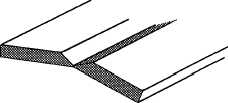
Figure 3-35.-Weld passes.
To control the forces of expansion and contraction, you preheat the entire structure before welding. After the welding is complete, you allow the structure to cool slowly. More about preheating and postheating is discussed later in this training manual.
Limit the Number of Weld Passes
You can keep distortion to a minimum by using as few weld passes as possible. You should limit the number of weld passes to the number necessary to meet the requirements of the job. (See fig. 3-35.)
Use Jigs and Fixtures
Since holding the metal in a fixed position prevents excessive movements, the use of jigs and fixtures can help prevent distortion. A jig or fixture is simply a device used to hold the metal rigidly in position during the welding operation.
Allow for Distortion
A simple remedy for the distortion caused by expansion and contraction is to allow for it during fit-up. To reduce distortion, you angle the parts to be welded slightly in the opposite direction in which the contraction takes place. When the metal cools, contraction forces pull the pieces back into position. Figure 3-36 shows how distortion can be overcome in both the butt and tee joints.
There is more to being a good welder than just being able to lay a good bead. There are many factors that must


Figure 3-36.-Allowing for distortion.
be considered. Later, we discuss additional techniques that you can apply to specific welding situations.
WELDING PROCEDURES
There are many factors involved in the preparation of any welded joint. The detailed methods and practices used to prepare a particular weldment are called the welding procedure. A welding procedure identifies all the welding variables pertinent to a particular job or project. Generally, these variables include the welding process, type of base metal, joint design, welding position, type of shielding, preheating and postheating requirements, welding machine setting, and testing requirements.
Welding procedures are used to produce welds that will meet the requirements of commonly used codes. The American Welding Society (AWS) produces the Structural Welding Code that is used for the design and construction of steel structures. Another code that is used for the construction of steam boilers and pressure vessels is published by the American Society of Mechanical Engineers (ASME). These codes provide a standardized guide of proven welding practices and procedures.
While you are not directly responsible for developing welding procedures, you could be assigned to a
Continue Reading